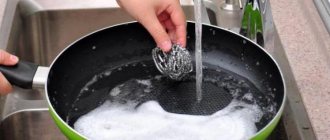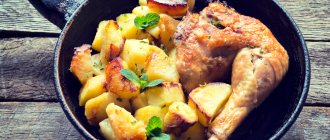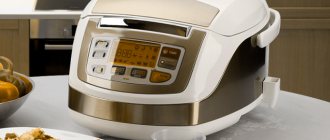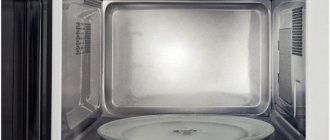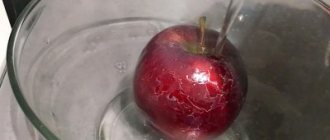Any kitchen utensil must perform its main function. The frying pan is designed for cooking food while preserving the taste and quality of the food. In some cases, a cast iron product does not cope with this task, because food sometimes burns on it.
Among household utensils, every family has a cast iron frying pan.
What can you cook in a cast iron frying pan?
Dishes made from this material are highly durable. Its shelf life, if used correctly, can be measured in decades. Cast iron weighs a lot, but will ultimately last a long time.
Strong, durable, it sometimes presents unpleasant surprises.
You can cook any dish in such a frying pan. When heated well, pancakes and pancakes are perfectly baked on it. Meat food is also easily prepared using a cast iron frying pan. You can fry vegetables, mushrooms and roast seeds on it.
In what other cases is it necessary to calcinate
Calcination is required not only for a new frying pan, but also for the sake of prevention and even getting rid of problems that have appeared on old ones.
- Cast iron frying pans often form carbon deposits - burnt oil. This is harmful to health, so you should not cook on such a surface. In this case, calcination will help, since it can destroy the accumulated carbon deposits, after which it will be easy to wash. Usually the question of how to properly burn a frying pan from soot is asked before cooking pancakes. This way the pan is cleared of old oil - even the first pancake will not be lumpy.
- If cast iron cookware begins to rust, then it must be properly treated to remove rust. First of all, it is necessary to clean the damaged areas. This can be done with a special product or a simple cleaning powder. After this, they are additionally sanded with fine-grain sandpaper. The cookware can then be baked to create a new protective coating to prevent future rust.
Why does food burn in a cast iron frying pan and what to do about it
This product is durable, but it has a significant drawback. Burning in such a frying pan will surprise few people. After repeated frying, food begins to stick to the bottom of the cast iron cookware as soon as it warms up.
When everything sticks to the bottom of a cast-iron frying pan, experienced housewives will tell you what to do.
This kind of trouble can arise for the following reasons:
- Incorrect operation. Food can burn even on a new cast iron frying pan if it was processed without taking into account the recommendations of specialists.
- Care not according to instructions. Any coating will fail prematurely if the utensils are used and stored incorrectly.
- Buying a fake. If you want to save on kitchen utensils, the chance of getting low-quality products increases. Defective goods will also affect the long-term use of the product.
There are several simple recipes for restoring the natural non-stick coating.
Important! If a problem arises, you should not send your cast iron frying pan to the scrap yard. It can be restored using simple steps with salt, oil, soda and other means.
Restoring non-stick properties
It is not always possible to clean a cast iron frying pan with a mild detergent; during cooking, food begins to stick and burn. Such contamination is removed by boiling water with detergent for several minutes. Remains of burnt food are removed with a plastic scraper.
Advice ! Salt is added to boiling water: it delicately cleanses and destroys bacteria.
Such manipulations imply further calcination of the product. Coating with oil before the procedure is the most effective method of restoring the non-stick properties of cast iron. The algorithm of actions is the same as after purchasing a frying pan.
How to prevent sticking of an aluminum frying pan
Aluminum is an inexpensive and durable metal. However, food can burn even on it. To avoid this trouble, you should do the following:
- Primary cleaning. This should include washing dishes with any non-abrasive product. Aluminum has small pores that are easily damaged when cleaning with a harsh substance.
- Use of oil. In this case, it is better to purchase a cotton hood. Oil must be poured into the frying pan so that it covers its entire bottom. A pinch of salt must be added to the viscous substance.
- Calcination. It is produced within half an hour. After this, the oil is drained and the pan is wiped with a paper napkin.
When the oxide layer wears unevenly or is destroyed by detergents, food begins to burn - it fills the recesses of the uneven bottom.
Why and why is it necessary to calcinate?
After purchase, any utensils must be washed before first use - everyone knows this. But for a cast iron frying pan, such care will not be enough, because during production it is lubricated with a special anti-corrosion compound, which prevents the dishes from rusting during storage in a warehouse, store or transportation.
Cast iron is a very porous material, so you can’t completely get rid of this anti-corrosion lubricant using dishwashing detergent. In addition, this lubricant has a very unpleasant aroma, which you also want to get rid of.
Thermal treatment of new dishes, namely calcination, or firing, will help with these tasks. Tempering will destroy harmful components and seal the pores of the cast iron, making the pan non-stick.
In addition, such heat treatment will serve as a litmus test that can identify defects or defects in the pan. It is better not to use the cookware if the following appears during heating :
- cracks;
- chips;
- cavities;
- violation of homogeneity;
- color change.
There are only two changes in the color of cast iron when heated, which are considered normal: to turn slightly brown or gray when heated and to turn black again when cooled.
Calcining a cast iron frying pan at home is a mandatory process before you start using it, because it:
- It will create an additional layer that will protect against the effects of alkalis and acids.
- It will create a non-stick coating, which will make cleaning your cookware easier.
- It will clog pores, destroying harmful substances of the anti-corrosion composition.
How to anneal and harden the cookware should be written in the instructions included with the purchase. Usually preferences are indicated there like:
- how to heat the oil,
- how long does it take to heat a cast iron frying pan, and so on.
If you don’t have these instructions, it doesn’t matter, since commissioning cast iron cookware is always based on the same principle.
What to do with a Teflon frying pan to prevent food from burning
This coating requires delicate care. What to do if a Teflon frying pan burns? In this case, vegetable oil will help. Teflon will last less than steel. However, its service life will increase after regular greasing of the bottom and walls of the frying pan.
The shelf life of Teflon quickly decreases if not properly maintained.
The thirtieth wash is a signal for the need to replenish the Teflon coating with vegetable oil. It should be heated, cooled and gently rubbed into the walls of an aluminum frying pan.
It should be taken into account that refurbished Teflon will not last long and the dishes will have to be replaced.
Impregnation
After cleaning, you need to close the pores of the cast iron so that it becomes glossy - then food will not burn on it. In addition, it is excellent protection against rust. The procedure is carried out in two ways.
Hot oil:
- Generously pour vegetable oil (preferably odorless) into the frying pan and spread it over the entire work surface with a brush, hand or rolling.
- Warm over medium heat for 25 minutes. Some of the oil should be absorbed.
- Let cool. Pour out the remainder and wipe dry with a paper towel.
We recommend: Why does a silver chain and cross on the body turn black?
Oil impregnation:
- Heat the frying pan over medium heat to about 100-150 degrees.
- Turn off the heat and add oil.
- Distribute with a brush, rubbing the seed squeeze into the walls and bottom.
- When there is almost no oil left, let the pan cool completely.
- Remove any remaining oil with a paper towel, partially rubbing it into the dish.
- Warm up briefly so that the oil is “baked” and excess moisture is removed.
Methods for heating a frying pan from sticking
This method of cleaning the surface of kitchen utensils allows you to rid them of unpleasant odors. After this treatment, food stops burning and sticking to the cast iron product.
Firing on the stove or in the oven
A cast iron frying pan burns - what to do in this case? Firing on the stove or in the oven is done after cleaning the inside of the pot. If there is burnt food on its walls, wash the frying pan several times under running water.
Normal calcination of a cast iron frying pan.
There is no particular difference between firing on the stove or in the oven. It all depends on the degree of contamination of kitchen utensils. In the oven, firing is carried out in a more delicate way than over direct fire. For this treatment, soda is usually used, which is boiled in water for 5 minutes.
If a cast iron frying pan burns, experienced housewives know what to do: cast iron needs to be calcined.
Dry firing of cast iron products is possible. It is produced after purchasing a new frying pan. Calcination lasts at least 10 minutes, after which the dishes can be used.
Burning with salt
A simple firing method is carried out in stages.
- Choice of salt. Coarsely ground substances are not suitable for tempering a frying pan. The use of fine salt in this case is encouraged. Its layer should completely cover the bottom of the cast iron cookware.
- Calcination. The process will take about an hour if you keep the pan on low heat. The salt should be stirred periodically for greater effect of heat treatment of the walls of the dishes.
- Trituration. After the kitchen utensils have completely cooled, they need to be further processed. The calcined salt must be thoroughly rubbed over the entire inside of the pan. To do this you will need a soft cloth or napkin.
For the procedure, coarse salt is used; it is more convenient to work with.
After burning with salt, utensils cannot be washed for two days. After the term is announced, the pan is rinsed in cold water.
Oil Quenching
There are several methods of such processing that will help prevent food from burning. The most effective of them looks like this.
- Rubbing with fat. It is better to use a piece of lard or vegetable oil. This remedy will help if you then place the pan in the oven.
- Heat treatment. Place cast iron cookware on a wire rack or baking sheet. Quenching with oil should last no more than an hour at a temperature of 100 – 150 ºC.
- Cleansing. The oil should be removed after processing. In this case, it is best to wipe the walls of the kitchen utensils with a napkin.
- Cooling down. After heat treatment, the pan should be placed in a cool place. You cannot wash it for three days after hardening with oil.
The surface is perfectly restored by oil firing.
Another way to prevent burning
To reduce the risk of food sticking and burning not only in cast iron, but in any cookware, use a fire spreader. Often carbon deposits occur where the gas burner flame was most intense. Evenly distributed heat heats food equally throughout the entire bottom of the container.
When a new cast iron skillet burns, it means you haven't prepared it for use. The newness of the metal is absolutely no guarantee that the utensils will not begin to act up. Be sure to heat the dishes in any convenient way.
Why does a cast iron frying pan smear black?
Reasons for the appearance of black spots on dishes.
- Defective goods. The surface of the pan may have been damaged during production. It is difficult to detect microcracks on it with the naked eye.
- Remains of fat base. During the manufacture of products, machine oil is used. In some cases it remains on the surface of the product.
- Incorrect care. Soda-based detergents are not always suitable for daily care of a cast iron frying pan.
It is important to remember that if you constantly take care of a cast iron frying pan, it will last for several generations, and you can fry whatever you want on it.
Attention! Black deposits on kitchen utensils can completely ruin the taste of a dish. It can be removed by calcination and other methods.
Care instructions
The main answer to the question of why a cast iron frying pan burns is considered to be improper care of it. To prevent damage to the product, you must follow simple rules.
After cleaning, always dry the dishes and store them in a dry place.
- Do not wait until a thick layer of soot forms on the pan . It has a bad effect on its operation.
- Clean the product regularly . Wipe the pan dry each time after cleaning.
- Store utensils correctly . Cast iron products are best stored in a dark, dry place where the risk of corrosion is minimal.
How to clean blackness from a frying pan
If you have an existing problem, you can try two ways to get rid of carbon deposits.
Lemon acid
There are two recipes for using this substance.
- Soap + citric acid. 4 tsp The caustic substance must be diluted in 2 liters of water. The resulting mixture should be boiled and kept on low heat for half an hour. Then the dishes are washed with a solution of laundry soap at the rate of half a piece of soap per liter of water. You can use any citric acid remover. However, for greater effect, you should use laundry soap.
- Vinegar + citric acid. The walls of the frying pan are treated with the resulting mixture while wearing gloves. It is prepared from 2 liters of water, 100 g of citric acid and 150 ml of vinegar. The liquid should be boiled, immerse the frying pan in it for half an hour, and then rinse the dishes under running water.
The burnt vessel is poured with an acidic solution.
Mustard powder
You can treat the walls of the frying pan with this caustic substance. They can really clean the inside and outside of it without damaging the coating of the product.
Mustard is an excellent remedy for fat and soot.
Recipe for carbon remover:
- Making pasta. Make it from 1 tsp. mustard powder and 100 ml of water.
- Surface treatment. Using a soft brush, you need to lubricate the problem areas of the dishes with blackening. The paste should be thoroughly rubbed into the surface of the pan.
If there is old carbon deposits, this recipe will not help. You need to add a little vinegar to the paste. Use the resulting mixture to treat black spots and do not wash it off for 5-6 hours. After this time, the dishes should be wiped with a soft sponge.
The hot processing method is boiling with mustard solution.
Soda and vinegar solution
This composition is used if food begins to burn due to rust. You can avoid the problem as follows:
- Selection of container. Its dimensions depend on the degree of damage to the walls of the cast iron frying pan. If most of it is damaged, then you will need a saucepan of impressive size.
- Treatment with soda and vinegar. In solution per 1 tsp. For each ingredient per liter of water, the dishes need to be soaked for three hours. If you shorten the processing time, vinegar and soda will not be able to dissolve the rust.
When sodium bicarbonate is quenched, oxygen is formed. It breaks down old dirt well.
Important! If you want to leave the product in the solution for four hours, there is a risk of destruction of the cast iron base of the cookware.
Cleaning with glue and soap
Carbon deposits can be removed using a simple recipe.
- Preparation of the composition. Its base is 0.5 kg of soda, 300 ml of office glue and crushed laundry soap. Mix the ingredients and add 1 liter of water.
- Warming up. The frying pan is placed in a large container and placed in the oven. The processing time of the dishes depends on the speed of separation of soot from its walls.
- Washing. It is produced in hot water using a brush with a soft base.
Pots, pans, cutlery, and bowls were cleaned by boiling in a solution of laundry soap and silicate glue.
Preparing for calcination
There are several ways to heat cast iron cookware, but before any of them, the frying pan or cauldron must be prepared. To do this, completely remove the original packaging and wash the dishes with a mild detergent or soap solution. It is better to avoid hard sponges so as not to damage the coating.
After this, the dishes must be wiped dry. If you choose the option of baking in the oven, you must remove the handle.
If the handle is made of plastic or wood and cannot be removed, then only the method of hardening the pan on the stove will do. The stove can be any - gas, electric or induction.
How to restore a cast iron frying pan from burning
In rare cases, this metal fails completely. The aluminum and Teflon layer has a much shorter service life. Restoring a cast iron frying pan depends on the type of damage. If it is scratched, it is better to treat it with sunflower oil after each cooking. To remove carbon deposits, you need to use soda, salt, citric acid or mustard powder.
By following simple rules, housewives save themselves and their loved ones from burnt food.
How to care for your frying pan
Cast iron is a material that is resistant to any deformation, and with proper care you can fry on it for many years. Its operation can be extended if certain rules are followed.
- Calcination. It is produced by heating it in the oven at a temperature of up to 180 C. In this case, it is better to use oil to create a non-stick layer.
- The washing up. A new frying pan should not be processed in cold water. Boiling water is also not suitable for preparing dishes for use. It is necessary to wash kitchen utensils in hot water with a soap base added to it. The brush for this treatment should not contain metal elements. It is better to opt for a soft sponge.
Before storing the frying pan, it is treated with an oiled cloth. In this form, the pan will not become rusty in high humidity.
Caring for cast iron cookware is not limited to primary processing. After using it, it is recommended to adhere to the following tips.
If food still begins to burn on cast iron utensils, it is easy to return the pan to its former versatility.
- Timely cleaning. A crust that forms on the surface of the pan is a signal that the pan is not being properly cared for. You should clean the utensils with a soft sponge and hot water after each cooking.
- Limit the use of soap. Water with a reasonable dosage will clean the surface of a cast iron frying pan. Bleach is not allowed when processing the contaminated part of such dishes.
- Regular drying. Food can burn and stick to the sides of a cast iron skillet if there is rust on the bottom. This problem can be avoided by drying the dishes after each use.
- Avoiding the dishwasher. The time saved will ultimately lead to breakdown of expensive equipment and damage to the surface of the cast iron frying pan.
- Using a wooden spatula. Some housewives believe that cast iron is not afraid of scratches. Such a misconception leads to the fact that their food then burns on a surface damaged by sharp objects.
- Storage on a stand. It is better to keep the frying pan separate from the rest of the dishes. A stand made of wood or stainless steel is suitable.
- Frequent use. Cast iron is a material that needs to be regularly treated with a fat base. In this case, it will last longer and rust will not form on it.
Products are placed only on a heated surface.
Attention! In case of significant contamination, you can resort to a radical method of cleaning the dishes. To do this, it is heated in the oven to 260 C. Residues of food eventually turn into ash and are easily removed with a napkin.
What should you do if your frying pan burns from time to time? The main thing is not to rush if you want to purchase a new product. A cast iron product will last for many years if you care for it properly.
Do not forget that in order for the dishes to serve reliably, they need to be properly cared for.
Advantages of cast iron cookware
Very heavy and quite expensive - is it worth buying a cast iron frying pan? Most chefs and experienced housewives answer: “Absolutely.”
The undeniable advantages of cast iron:
- it retains heat for a long time, releasing it gradually - the dish is cooked evenly, creating the effect of cooking in an oven; no modern analogue gives the same effect;
- for the same reason, a cast iron frying pan is ideal for grilled meats;
- incredibly durable: cast iron is only afraid of rust, but protection against it is elementary;
- since it is not coated with Teflon or ceramics, it is absolutely not capricious, it is not afraid of overheating, a metal spatula or spoon, it can even be cleaned with a metal scraper (as a last resort);
- Having wiped off the dirt in the harshest way, just warm up the pan again and grease it with oil - the non-stick and anti-corrosion coating is restored;
- tolerant to all heating methods: calmly frying, stewing and baking in the oven, on a fire or gas stove, regular or induction panel;
- Cast iron is fragile, but very hard material, and you can safely fry nuts, bone-in meat, and other hard foods on it.
A cast iron frying pan allows you to cook incredibly tasty, delicate dishes. Its main drawback is its fragility (it doesn’t tolerate sharp blows well) and its impressive weight (it’s better to straighten pancakes on this one with a special turntable or the bottom of a ladle, and store the dishes on the middle or lower shelves). To ensure that the frying pan lasts longer, does not rust or burn food, it is enough to treat it with oil and reduce the heat in time.

